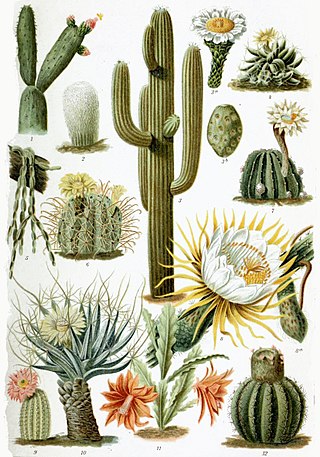
A cactus is a member of the plant family Cactaceae, a family of the order Caryophyllales comprising about 127 genera with some 1,750 known species. The word cactus derives, through Latin, from the Ancient Greek word κάκτος (káktos), a name originally used by Theophrastus for a spiny plant whose identity is now not certain. Cacti occur in a wide range of shapes and sizes. They are native to the Americas, ranging from Patagonia in the south to parts of western Canada in the north, with the exception of Rhipsalis baccifera, which is also found in Africa and Sri Lanka. Cacti are adapted to live in very dry environments, including the Atacama Desert, one of the driest places on Earth. Because of this, cacti show many adaptations to conserve water. For example, almost all cacti are succulents, meaning they have thickened, fleshy parts adapted to store water. Unlike many other succulents, the stem is the only part of most cacti where this vital process takes place. Most species of cacti have lost true leaves, retaining only spines, which are highly modified leaves. As well as defending against herbivores, spines help prevent water loss by reducing air flow close to the cactus and providing some shade. In the absence of true leaves, cacti's enlarged stems carry out photosynthesis.

In musical instrument classification, string instruments, or chordophones, are musical instruments that produce sound from vibrating strings when a performer strums, plucks, strikes or sounds the strings in varying manners.
Hornbostel–Sachs or Sachs–Hornbostel is a system of musical instrument classification devised by Erich Moritz von Hornbostel and Curt Sachs, and first published in the Zeitschrift für Ethnologie in 1914. An English translation was published in the Galpin Society Journal in 1961. It is the most widely used system for classifying musical instruments by ethnomusicologists and organologists. The system was updated in 2011 as part of the work of the Musical Instrument Museums Online (MIMO) Project.

An idiophone is any musical instrument that creates sound primarily by the vibration of the instrument itself, without the use of air flow, strings (chordophones), membranes (membranophones) or electricity (electrophones). It is the first of the four main divisions in the original Hornbostel–Sachs system of musical instrument classification. The early classification of Victor-Charles Mahillon called this group of instruments autophones. The most common are struck idiophones, or concussion idiophones, which are made to vibrate by being struck, either directly with a stick or hand or indirectly, with scraping or shaking motions. Various types of bells fall into both categories. A common plucked idiophone is the Jew's harp.

Fouquieria splendens is a plant indigenous to the Mojave Desert, Sonoran Desert, Chihuahuan Desert and Colorado Desert in the Southwestern United States, and northern Mexico.
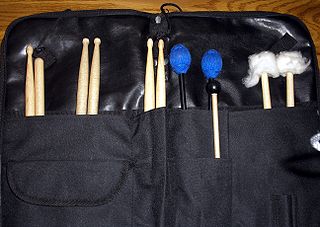
A percussion mallet or beater is an object used to strike or beat a percussion instrument to produce its sound.
Struck idiophones is one of the categories of idiophones that are found in the Hornbostel-Sachs system of musical instrument classification.

The ugly stick is a Newfoundland musical instrument fashioned out of household and tool shed items, typically a mop handle with bottle caps, tin cans, small bells and other noise makers. The instrument is played with a drum stick or notched stick and has a distinctive sound.
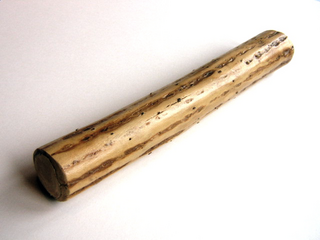
The word shaker describes various percussive musical instruments used for creating rhythm in music.

The güira is a percussion instrument from the Dominican Republic used in merengue, bachata, and to a lesser extent, other genres such as cumbia. It is made of a metal sheet and played with a stiff brush, thus being similar to the Haitian graj and the Cuban guayo and güiro. Güira, guayo and güiro all have a function akin to that of the indigenous native maracas or the trap-kit's hi-hat, namely providing a complementary beat.
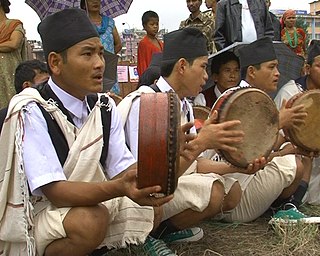
A damphu, or damfoo, is a percussion instrument similar to a large tambourine. This instrument is used by the Tamang people of Nepal to play the melodious Tamang Selo. According to folklore Damphu was invented by Peng Dorje, a Tamang King and named it after Nepal's national bird the Daphne bird. It is also played by the gurung and magar people of nepal.

The kashaka is a simple percussion instrument consisting of two small gourds filled with beans One gourd is held in the hand and the other is quickly swung from side to side around the hand, creating a "clack" sound upon impact. It originated in West Africa, but has been reproduced in various countries under different names: Patica (Japan), Kosika (USA). Other names include Asalato, Kes Kes, Tchangot Tche, Koshkah, and many others.
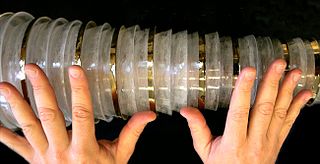
Friction idiophones is designation 13 in the Hornbostel-Sachs system of musical instrument classification. These idiophones produce sound by being rubbed either against each other or by means of a non-sounding object. Instruments of this type are not very common; possibly the best known examples are the musical saw and the nail violin.

A cactarium or cactuario is a garden dedicated to the planting of cacti. While they generally specialize in collecting cacti, they can also include other desert plants such as sabla, agaves or Crassulaceae, although this would better be termed "xeriscaping".

Bamboo's natural hollow form makes it an obvious choice for many musical instruments. In South and South East Asia, traditional uses of bamboo the instrument include various types of woodwind instruments, such as flutes, and devices like xylophones and organs, which require resonating sections. In some traditional instruments bamboo is the primary material, while others combine bamboo with other materials such as wood and leather.
ʻUlīʻulī are Hawaiian feathered gourd rattles that are occasionally used as instruments in the traditional Hawaiian dance, hula. This instrument is used in both ʻauana and kahiko hula dances. They are vibrantly colored feather gourd rattles used in kahiko performances to maintain timing and to enhance other sounds like chanting or the pounding of an ipu.

The tube zither is a stringed musical instrument in which a tube functions both as an instrument's neck and its soundbox. As the neck, it holds strings taut and allows them to vibrate. As a soundbox, it modifies the sound and transfers it to the open air. The instruments are among the oldest of chordophones, being "a very early stage" in the development of chordophones, and predate some of the oldest chordophones, such as the Chinese Se, zithers built on a tube split in half. Most tube zithers are made of bamboo, played today in Madagascar, India, Southeast Asia and Taiwan. Tube zithers made from other materials have been found in Europe and the United States, made from materials such as cornstalks and cactus.
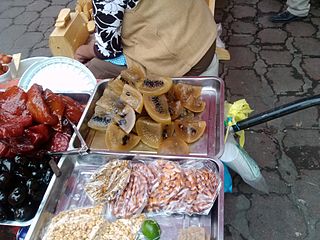
The acitrón is a Mexican candy which is commonly used as a decoration on a three kings' cake. As an ingredient, it has great cultural significance since it is used in a large number of ritual and festive preparations. Unfortunately, the biznaga cactus from which acitróns are made is an endangered species due to excessive consumption.















